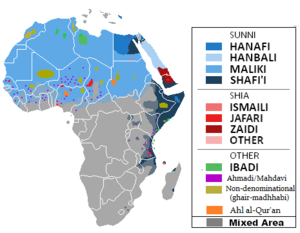
| Islam by country |
|---|
 |
|
|
Virtually all Mauritanians are Sunni Muslims. They adhere to the Maliki madhhab, one of the four Sunni schools of law. Since independence in 1960, Mauritania has been an Islamic republic. The Constitutional Charter of 1985 declares Islam the state religion and sharia the law of the land.
YouTube Encyclopedic
-
1/5Views:18 0793 45926 66037 47831 505
-
Learning Arabic in Nabbaghiyya, Mauritania in 3 months
-
Reflections on Mauritania | Shaykh Hamza Yusuf
-
Recounting My Mauritanian Learning Experience | Shaykh Saeed al-Kamali
-
Shaykh Hamza Yusuf Returns to Mauritania After 30 Years
-
Studying in Mauritania
Transcription
History

The Umayyads were the first Arab Muslims to enter Mauritania. During the Islamic conquests, they made incursions into Mauritania and were present in the region by the end of the 7th century.[1] Many Berber tribes in Mauritania fled the arrival of the Arabs to the Gao region in Mali.[2]
It was not until the nineteenth century that the brotherhoods (Sufism and tariqa) assumed importance when they attempted to make religion a force for expanding identities and loyalties beyond the limits of kinship. The relative peace brought to the area by French administration and the growing resentment of colonial rule contributed to the rapid rise in the power and influence of the brotherhoods. In recent decades, these orders have opposed tribalism and have been an indispensable element in the growth of nationalist sentiment. Since the Ahmadiyya Islamic movement has a large presence in West Africa, the African Muslim Congress met in Mauritania in 1976 to call upon African nations to regard Ahmadi Muslims as apostates, though with little success.[3]
Sufi brotherhoods
In the 1980s, two brotherhoods (tariqa), the Qadiriyyah and the Tijaniyyah, accounted for nearly all the brotherhood membership in Mauritania. The Qadiriyyah and Tijaniyyah were essentially parallel "ways," differing primarily in their methods of reciting the litanies. Their Islamic doctrines and their religious obligations were basically similar. Two smaller brotherhoods also existed — the Shadhiliyyah, centered in Boumdeït in Tagant Region, and the Goudfiya, found in the regions of Tagant, Adrar, Hodh ech Chargui, and Hodh el Gharbi.
See also
References
- ^ Sabatier, Diane Himpan; Himpan, Brigitte (28 June 2019). Nomads of Mauritania. ISBN 9781622735822.
- ^ Sabatier, Diane Himpan; Himpan, Brigitte (28 June 2019). Nomads of Mauritania. ISBN 9781622735822.
- ^ Marloes Janson (2014). Islam, Youth and Modernity in the Gambia: The Tablighi Jama'at. Cambridge University Press. p. 79. ISBN 9781107040571. Retrieved May 31, 2014.
 This article incorporates text from this source, which is in the public domain. Country Studies. Federal Research Division.
This article incorporates text from this source, which is in the public domain. Country Studies. Federal Research Division.
